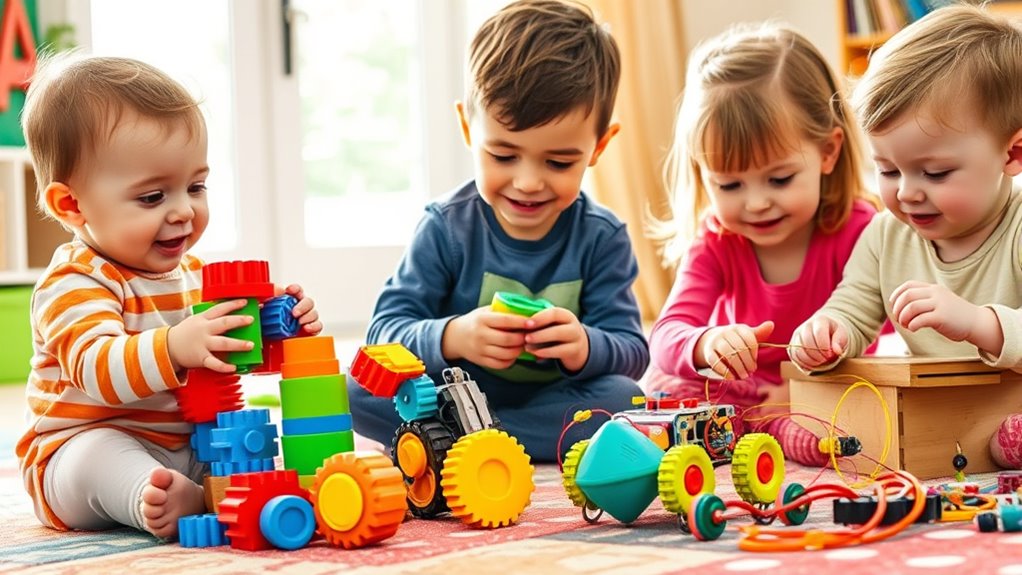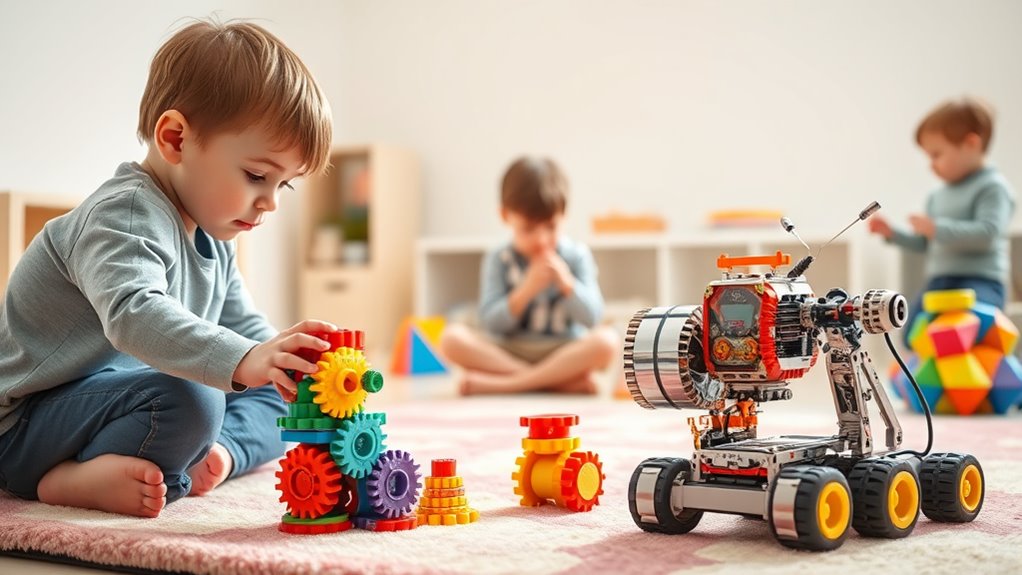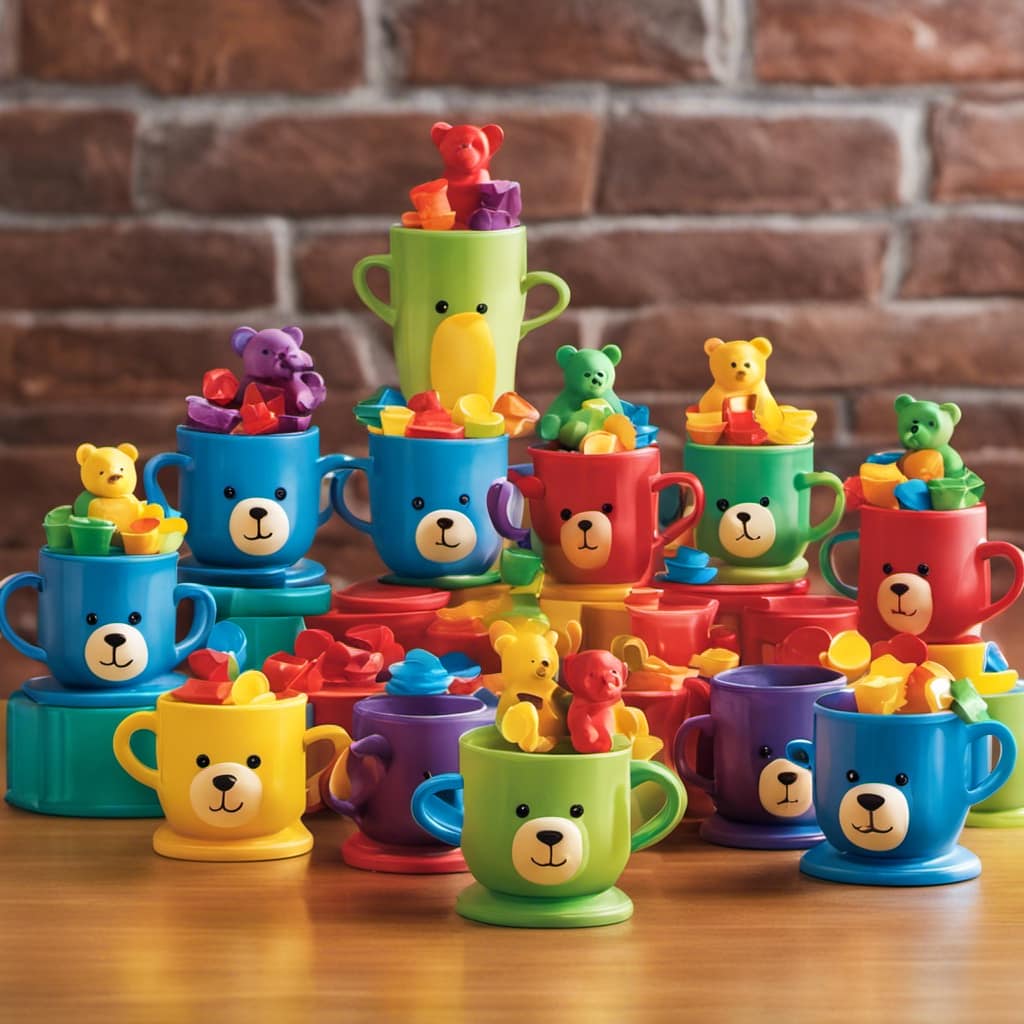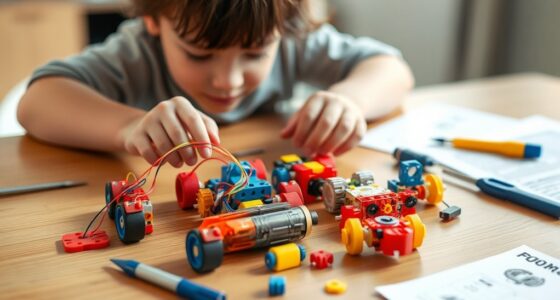Choosing age-appropriate STEM toys guarantees your child stays motivated, learns effectively, and builds key skills suited to their developmental stage. For younger kids, seek simple robot kits with colorful pieces and interactive features to develop fine motor skills and curiosity. As they grow, introduce more complex projects with sensors and coding elements to challenge their problem-solving. Keeping toys aligned with their abilities keeps learning fun and engaging—continue exploring to find the perfect fit for each stage.
Key Takeaways
- Match toy complexity to your child’s developmental stage to ensure engagement and prevent frustration.
- For younger children, choose simple, hands-on building kits with colorful, chunky parts.
- Older kids benefit from more advanced kits with sensors, coding, and problem-solving challenges.
- Consider your child’s interests—whether they enjoy storytelling, engineering, or programming—to select suitable toys.
- Regularly assess and upgrade toys to match evolving skills, promoting continuous learning and motivation.

STEM toys for kids have become increasingly popular because they combine learning with fun, encouraging children to explore science, technology, engineering, and math through hands-on activities. When choosing the right toys for your child, it’s essential to contemplate their age and developmental stage. For younger kids, simple robot building kits introduce basic engineering concepts and help develop fine motor skills. These kits often feature chunky pieces, colorful parts, and easy-to-follow instructions, making the process engaging without feeling overwhelming. As they grow, they can advance to more complex robot building projects that challenge their problem-solving abilities and spark creativity. Building robots not only teaches mechanical skills but also fosters patience and perseverance, as kids learn to troubleshoot and improve their designs. Incorporating age-appropriate STEM toys ensures that children remain motivated and engaged at every developmental stage. Coding games are another excellent way to introduce children to programming concepts in a fun and approachable manner. For preschoolers and early elementary students, visual programming apps with drag-and-drop interfaces keep the experience intuitive and accessible. These games often involve guiding characters through mazes or completing puzzles, which subtly build logical thinking and sequencing skills. As your child matures, they can graduate to more sophisticated coding platforms that teach text-based programming languages like Scratch or Python. These tools help develop critical thinking and computational thinking, laying a solid foundation for future tech learning. When selecting age-appropriate STEM toys, think about your child’s interests and current abilities. For younger children, toys that combine simple robot building with interactive features—such as voice commands or light-up parts—can make the experience more engrossing. For older kids, more advanced robotics kits that include sensors, motors, and coding components challenge them to create functional machines that perform real-world tasks. Coding games that incorporate storytelling or game design elements also make learning more engaging, encouraging kids to experiment and iterate.
Frequently Asked Questions
How Do I Choose STEM Toys That Match My Child’s Learning Style?
When choosing STEM toys, consider your child’s learning styles—do they prefer hands-on activities, visual cues, or auditory feedback? Look for toy features that align with these styles, like tactile elements for kinesthetic learners or bright visuals for visual learners. Pay attention to how your child interacts with the toy, and select options that encourage exploration and problem-solving, ensuring the toy supports their unique way of learning.
Are There Any Safety Concerns With Small Parts in STEM Toys?
When considering safety concerns with small parts in STEM toys, ask yourself: are choking hazards present, and do they align with age restrictions? You should always check for choking hazards, verify small parts are suitable for your child’s age, and follow age restrictions carefully. Keep a close eye on toys with tiny components, and choose options that match your child’s maturity level to prevent accidents and promote safe, engaging play.
How Can STEM Toys Support Children With Special Needs?
You can support children with special needs by choosing STEM toys that promote adaptive learning and sensory integration. These toys help children develop skills at their own pace while engaging multiple senses, which can improve focus and coordination. By selecting toys tailored to their individual needs, you encourage confidence and independence. Always consider their specific sensory sensitivities and learning styles to maximize the benefits of STEM play.
What Are the Best STEM Toys for Mixed-Age Sibling Play?
Imagine turning playtime into a delightful dance of discovery. For mixed-age sibling play, choose versatile STEM toys that promote multi-age collaboration and sibling bonding. Building sets, robotics kits, or science experiment kits with adjustable complexity are perfect. These toys encourage teamwork, spark curiosity, and guarantee everyone’s engaged, regardless of age. Your kids will love exploring together, strengthening their bond while learning new skills through fun, shared experiences.
How Do I Encourage Sustained Interest in STEM Activities?
To keep your child engaged in STEM activities, use effective engagement strategies like hands-on experiments and real-world applications. Incorporate motivation techniques such as setting achievable goals and celebrating successes to boost their confidence. Encourage curiosity by asking open-ended questions and offering challenges that match their interests. By making activities fun and relevant, you’ll foster sustained interest and help them develop a lasting love for STEM.
Conclusion
Choosing the right STEM toys for each age isn’t just important—it’s like opening a secret portal to genius! Imagine giving your child the key to a future filled with innovation, curiosity, and unstoppable creativity. Every toy you pick sparks a wildfire of learning that burns brighter with each stage. So, explore deeply, pick wisely, and watch your little one transform into a superhero of science, technology, engineering, and math—because the right toy can change everything!










